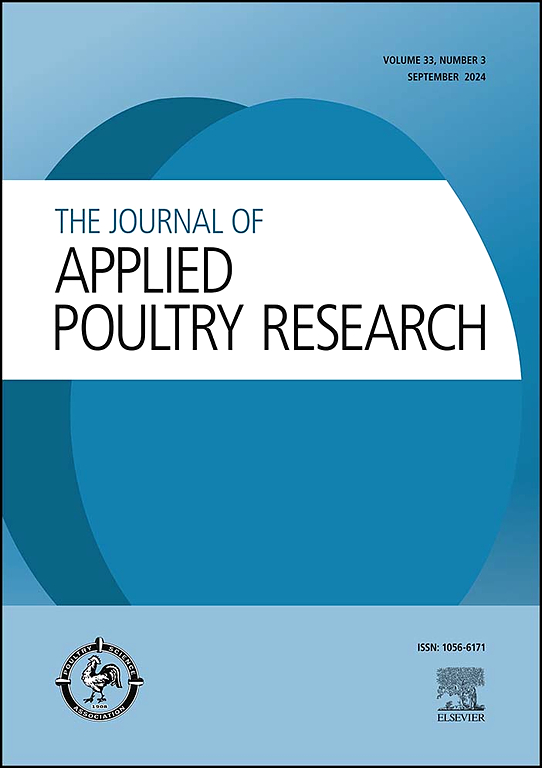Effect of trans-cinnamaldehyde and peracetic acid alone or in combination on multidrug-resistant Salmonella Heidelberg on broiler drumsticks under scalding alone or with chilling and storage in sequence
IF 2
3区 农林科学
Q2 AGRICULTURE, DAIRY & ANIMAL SCIENCE
引用次数: 0
Abstract
This study determined the antibacterial effect of trans-cinnamaldehyde (TC), peracetic acid (PAA), and their combination against Salmonella Heidelberg on broiler drumsticks at scalding conditions alone or with chilling and storage in sequence. Broiler chicken drumsticks were inoculated with a low (∼3.0 log10 CFU/g) or high (∼4.5 log10 CFU/g) concentration of S. Heidelberg. They were immersed in treatment water containing 0.5 % TC, 1 % TC, 0.05 % PAA, 0.5 % TC + 0.05 % PAA, and 1 % TC + 0.05 % PAA at 54 °C for 2 min. The drumsticks inoculated with S. Heidelberg and without any antimicrobial treatment in scalding water were positive controls (PC). After scalding, the drumsticks were rinsed in 350 mL phosphate-buffered saline (PBS) for 30 s to obtain surviving S. Heidelberg populations enumerated by surface plating and enrichment methods. Additionally, the efficacy of the scalding treatments (PC, 1 % TC, 0.05 % PAA, and 1 % TC + 0.05% PAA) against S. Heidelberg survival on drumsticks after chilling and chilled storage in sequence was determined. At least six replicates per treatment were present in each experiment. Results revealed that PAA and its combination with TC (0.5 or 1 %) resulted in the significant reduction of S. Heidelberg on drumsticks at both inoculum levels (P < 0.05). Moreover, the treatments inactivated S. Heidelberg to non-detectable levels in the scalding water (P < 0.05). The scalding treatments also inhibited S. Heidelberg on the drumsticks during chilled storage without affecting the surface color of the drumsticks (P > 0.05). The study indicated that TC, PAA, or their combinations could be antimicrobials for S. Heidelberg control in poultry processing.
反式肉桂醛和过氧乙酸单独或联合使用对肉鸡鸡腿单烫或顺序冷藏下多重耐药海德堡沙门氏菌的影响
研究了反式肉桂醛(TC)、过氧乙酸(PAA)及其组合对肉鸡鸡腿在单独和顺序冷藏条件下对海德堡沙门氏菌的抗菌作用。用低浓度(~ 3.0 log10 CFU/g)或高浓度(~ 4.5 log10 CFU/g)的海德堡菌接种肉鸡腿。分别于含0.5% TC、1% TC、0.05% PAA、0.5% TC + 0.05% PAA、1% TC + 0.05% PAA的处理水中54℃浸泡2 min。接种了海参菌的鸡腿在沸水中未经任何抗菌处理为阳性对照(PC)。将鸡腿在350 mL磷酸盐缓冲盐水(PBS)中冲洗30 s,通过表面电镀和富集方法获得存活的海德堡s。此外,研究了PC、1% TC、0.05% PAA和1% TC + 0.05% PAA对鸡腿冷却和冷藏后海德堡菌存活的影响。每个试验中每个处理至少有6个重复。结果表明,PAA及其与TC(0.5%或1%)的联用均能显著降低鸡腿上的海德堡鸡(P <;0.05)。此外,这些处理使S. Heidelberg在沸水中失活到不可检测的水平(P <;0.05)。在冷藏过程中,烫伤处理也抑制了鸡腿上的海德堡菌,而不影响鸡腿的表面颜色(P >;0.05)。本研究表明,TC、PAA或其组合可作为家禽加工中控制海德堡沙门氏菌的抗菌剂。
本文章由计算机程序翻译,如有差异,请以英文原文为准。
求助全文
约1分钟内获得全文
求助全文
来源期刊

Journal of Applied Poultry Research
农林科学-奶制品与动物科学
CiteScore
4.10
自引率
10.50%
发文量
80
审稿时长
104 days
期刊介绍:
The Journal of Applied Poultry Research (JAPR) publishes original research reports, field reports, and reviews on breeding, hatching, health and disease, layer management, meat bird processing and products, meat bird management, microbiology, food safety, nutrition, environment, sanitation, welfare, and economics. As of January 2020, JAPR will become an Open Access journal with no subscription charges, meaning authors who publish here can make their research immediately, permanently, and freely accessible worldwide while retaining copyright to their work. Papers submitted for publication after October 1, 2019 will be published as Open Access papers.
The readers of JAPR are in education, extension, industry, and government, including research, teaching, administration, veterinary medicine, management, production, quality assurance, product development, and technical services. Nutritionists, breeder flock supervisors, production managers, microbiologists, laboratory personnel, food safety and sanitation managers, poultry processing managers, feed manufacturers, and egg producers use JAPR to keep up with current applied poultry research.
 求助内容:
求助内容: 应助结果提醒方式:
应助结果提醒方式:


